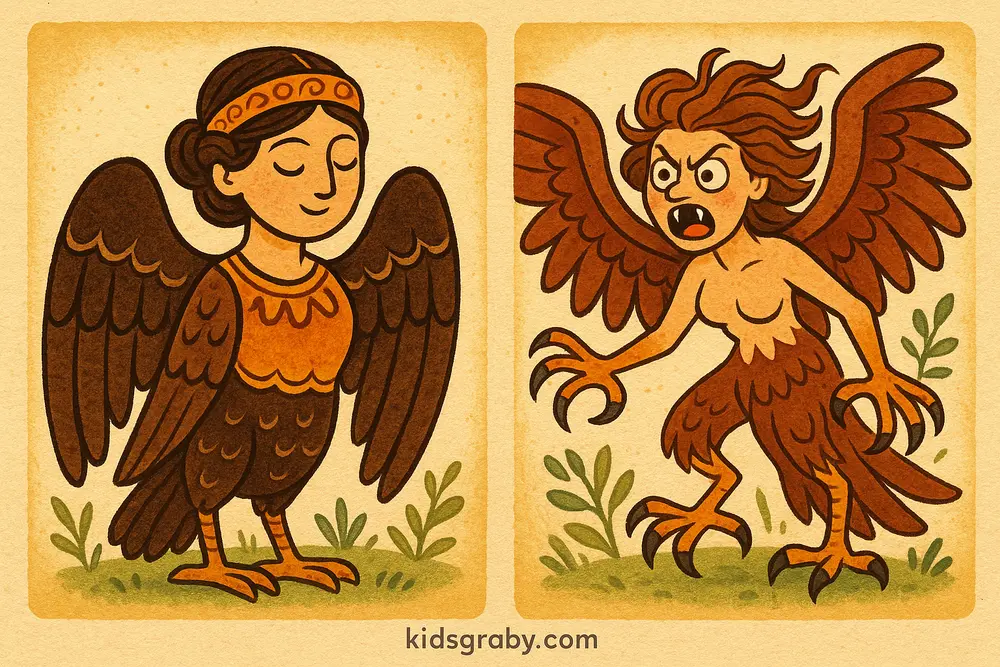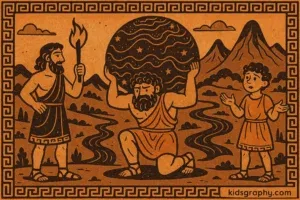In the world of Greek mythology, not every creature was noble or kind. Some were wild, untamed, and terrifying—sent to punish or torment. One of the most fearsome and mysterious of these beings was the Harpy.
Let’s explore the harpy in Greek mythology, uncovering their origins, meaning, powers, and the strange mix of fear and fascination they inspired.
Read More: Hermes in Greek Mythology: Messenger of the Gods
What Is a Harpy in Greek Mythology?
A Harpy (plural: Harpies) is a mythological creature that is part bird, part woman. In most stories, they have the body of a large bird of prey with sharp claws, and the head or upper body of a woman, often with long hair flying in the wind.
They are known for their speed, their screeching cries, and their role as agents of punishment.
The Meaning of the Word “Harpy”
The word “Harpy” comes from the Greek word harpazein, meaning “to snatch” or “to seize”. This fits perfectly with their mythological role—they would swoop down from the sky and snatch away people, souls, or food.
So, the harpy Greek mythology meaning is tied to sudden, violent capture—they are symbols of stormy winds that come without warning.
Read More: Hephaestus: The Amazing Greek God of Fire and Forging!
Harpy in Greek Mythology: Key Stories
The Harpies and King Phineus
One of the most famous stories comes from the Argonautica, where the Harpies were sent by the gods to torment King Phineus, a prophet who revealed too many divine secrets.
Every time Phineus tried to eat, the Harpies would swoop down, steal the food, and leave behind a horrible smell. The hero Jason and the Argonauts arrived to help him, and the winged brothers Zetes and Calais chased the Harpies away.
In some versions, the Harpies are killed. In others, they are spared and flee to a far-off land.
Harpies and the Underworld
Harpies are sometimes linked to the underworld, acting as spirits who escort the dead, or even as torturers of the guilty. Their presence in myths is a mix of natural power and moral judgment.
Harpy Greek Mythology Facts
Here are some quick, fascinating facts about harpies in Greek myths:
- They were daughters of Thaumas and Electra, sea and cloud deities.
- Early Harpies were described as beautiful winged maidens—but later myths turned them into monstrous hags.
- They were often blamed for mysterious disappearances or violent storms.
- The Roman poet Virgil wrote about them in the Aeneid, where they cursed Aeneas and his men.
- In art, Harpies appeared on vases, statues, and coins across ancient Greece and Rome.
Male Harpy in Greek Mythology?
Unlike other mythological creatures like centaurs or satyrs, Harpies are almost always female. There is no known male harpy in classic Greek mythology. Their role—punishment and spiritual vengeance—was often linked to feminine energy and divine justice.
So when people ask about a male harpy in Greek mythology, it’s worth noting that they don’t appear in ancient texts. The harpy is a symbol of female fury and chaotic wind, with no male counterpart.
Read More: Pandora in Greek Mythology: The First Woman’s Curse
Harpies in Modern Art and Culture
Today, Harpies appear in:
- 🎮 Video games like God of War and Hades
- 📚 Fantasy novels where they’re often reimagined as misunderstood creatures
- 🎨 Fan art—some draw them as elegant winged women, others as feral beasts of wind and wrath
Even though they began as symbols of fear, modern versions of Harpies explore themes of power, freedom, and transformation.
Read More:
Final Thoughts: The Wild Wind of Myth
The harpy in Greek mythology reminds us that not all divine messengers are kind. Some bring chaos, judgment, or justice. These winged spirits were born from wind and storm, and they still fly through our stories today.
Whether seen as monsters or misunderstood guardians, Harpies teach us that myths are not always about beauty—they’re also about the wild forces we can’t control.
Read More: Persephone in Greek Mythology: Queen of the Underworld
Symbolism of the Harpy in Ancient Greece
In ancient Greek culture, Harpies were not just terrifying monsters. They symbolized the raw forces of nature, especially storm winds and divine punishment.
Here’s what they represented:
- Sudden change – Harpies were thought to arrive without warning, much like a strong gust that changes everything.
- Moral justice – When people angered the gods or crossed moral lines, Harpies were sent to torment them as divine agents.
- The power of fear – In myth, fear wasn’t always a bad thing. Harpies taught people to respect the natural world and the gods.
Because they lived between the worlds of gods, humans, and the underworld, Harpies were spiritual messengers of warning—not unlike other winged beings found in global mythologies.
Read More: Typhon in Greek Mythology: The Father of Monsters
Harpies in Ancient Art
Early Greek art from the 6th and 5th centuries BCE shows Harpies in more elegant, even beautiful forms—with wings, flowing hair, and gentle expressions.
But over time, their image became darker and more frightening:
- Hellenistic and Roman art often portrayed them with twisted bodies, long claws, and fierce eyes.
- Harpies were sometimes carved on gravestones to show spirits being taken to the afterlife.
- They were also depicted in battle scenes, especially when gods sent them to punish mortals.
This transformation—from graceful sky maidens to terrifying storm demons—reflects how myths evolve with cultural fears and beliefs.
Harpies in Modern Stories and Fantasy
Today, Harpies have spread beyond ancient myths and appear in books, movies, games, and fantasy art:
- In Dungeons & Dragons, Harpies are common winged enemies who lure adventurers with enchanting voices.
- In Rick Riordan’s Camp Half-Blood Chronicles, Harpies appear as fierce protectors of sacred areas.
- Many fantasy books reimagine Harpies as either guardians of nature or outcast beings seeking redemption.
In feminist retellings and fan fiction, some writers even give Harpies a voice, turning them into symbols of rage, power, or justice rather than mere monsters.
Read More: Titans in Greek Mythology: Gods Before Olympus
Cultural Influence Beyond Greece
The Harpy’s concept also influenced myths in other cultures:
- Roman mythology adopted the Harpy without many changes, reinforcing their role in the Aeneid.
- In Medieval Christian art, Harpy-like beings appeared as warnings of sinful behavior and divine wrath.
- The word “harpy” even entered modern language, sometimes unfairly used to describe nagging or aggressive women—a reflection of ancient misogynistic fears.
Despite this, modern readers and creators are reimagining Harpies as complex, misunderstood beings, challenging their one-dimensional portrayal in old myths.
More Stories: Greek Mythology
FAQ: Harpy in Greek Mythology
A harpy is a creature with the body of a bird and the face of a woman, known for snatching people or food and serving as a tool of divine punishment.
Harpies were feared but not always evil. They acted on the gods’ orders, especially when punishing mortals or escorting souls to the underworld.
The word comes from the Greek harpazein, meaning “to snatch.” It reflects their role in seizing people or objects suddenly.
No, all known harpies in Greek mythology are female. Male versions do not appear in classical stories.
They appear in the tale of King Phineus, who was tormented by harpies stealing his food, and in Roman myths like Virgil’s Aeneid.
Read More: Cronus in Greek Mythology: Titan of Time and Power











